From Bali to Kuala Lumpur
Not much is known about Malaysia, right? Unlike its neighbors in Southeast Asia such as Indonesia, Thailand, Vietnam or Singapore for example, Malaysia is still little known. However, for those who want to visit Kuala Lumpur, the capital of Malaysia, it is the assurance of experiencing a radical change, as much on the religious level as on the climate, habits or local gastronomy. But what can you see in Kuala Lumpur? How do you make people want to discover this wonderful city that never seems to rest? There are many direct flights from Bali to Kuala Lumpur and it takes 2 hours 45 minutes. And this is the fastest way to get from Bali to Kuala Lumpur.
Direct airlines from Bali to Kuala Lumpur (from DPS to KUL)
- AirAsia
- Batik Air (previously operated as MalindoAir)
- Malaysia Airlines
Airlines from Bali to Kuala Lumpur with stops (Undirect)
- Citilink (with 1 stop in Jakarta CGK)
- Singapore Airlines (with 1 stop in Singapore)
- Garuda Indonesia (with 1 stop in Jakarta CGK)
Things to do and see in Kuala Lumpur
It is simply called “KL” by most residents. Many different cultures and religions are represented in the metropolis, you can see minarets of the mosques, Christian church towers, Chinese pagodas and Indian temples throughout the city.
The melting pot of Malay, Chinese and Indian cultures form a curious mixture at first glance, but everything seems to work well… the infrastructures are modern, the roads are well maintained, there are many greens, there are great restaurants and almost everything can be visited on foot.
Petronas Twin Tower
Erected in 1996, the Petronas Towers were the tallest in the world at the time (standing at 451.9 metres or 1,483 feet). They mix modern and Islamic architecture. A bridge connects the two towers that can be visited. Right at the foot of the towers is the KLCC, a huge shopping center where you can enjoy the air conditioning. There are international brand stores, many restaurants, a cinema, a supermarket…

Petronas Towers in Kuala Lumpur. Someformofhuman, CC BY-SA 4.0, via Wikimedia Commons
Don’t miss a walk in the park located just in front of the towers. If you stick around in the evening there is a sound and light show with the fountains located in the small lake at the foot of the towers. Finally, to enjoy a great view of the Petronas Towers, you can go to the skybar located on the 33rd floor of the Traders Hotel (don’t forget your swimsuit, there’s even a swimming pool!).

Water fountain on Symphony Lake. KLCC Park. Kuala Lumpur, Malaysia. Photo: Marcin Konsek (CC BY-SA 4.0) / Wikimedia Commons
TV Tower
Also called the Menara Tower, this tower dominates the urban landscape of Kuala Lumpur with a height reaching 421 meters (note that the Eiffel Tower rises up to 320 meters “only”!). To access it, you have to go through a platform that is 276 meters above the ground. For those who can afford to spend a little money, it is absolutely necessary to have a meal at the restaurant which is located at the very top of the tower, thus enjoying a sensational 360° panorama over the whole of Kuala Lumpur.
Many different activities are offered in the Menara tower such as a Formula 1 simulator or the opportunity to learn everything you have always dreamed of knowing about Malaysian culture.

KL Tower (Menara Kuala Lumpur) in Kuala Lumpur, Malaysia. Photo by CEphoto, Uwe Aranas (CC BY-SA 3.0) via Wikimedia Commons
Bukit Bintang, shopping district and nightlife in KL
A very lively shopping district where you have to come in the evening. There is a huge shopping center there, the Pavilion KL (thanks again for the air conditioning!) with a great food court where you can eat. There are also quite a few bars nearby. If you want to shop in KL, this is the place to go. Bukit Bintang is not far from Jalan Alor.
Bukit Bintang (or Hill of Stars in Malay) is a commercial and entertainment district of Kuala Lumpur. This area is home to many cafes, pubs, hotels, restaurants and shopping malls. It is well known to tourists and local youth.

Pavilion, Bukit Bintang – Kuala Lumpur. Renek78, CC BY-SA 4.0, via Wikimedia Commons
Bukit Bintang is located between three main arteries: Jalan Bukit Bintang, Jalan Pugu and Jalan Sultan Ismail. Many restaurants, sometimes right on the street, offer food at a democratic price in a relaxed atmosphere. Most of the restaurants are Asian such as Chinese, Indian, Malay, Thai and Indonesian.
This area is well known for its nightlife, as well as gatherings during the New Year and Malaysian Independence Day celebrations.
The area is served by the KL monorail, the Kuala Lumpur Urban Metro, Bukit Bintang station.
Bukit Bintang: crossing between Jalan Sultan Ismail and Jalan Bukit Bintang. Patrice78500, Public domain, via Wikimedia Commons
Kuala Lumpur railway station
The station is notable for its architecture, adopting a mixture of Eastern and Western styles. Completed in 1910, it replaces an old station that was on the same site. The current infrastructure was the Kuala Lumpur rail hub for the Federated Malay States Railways and the Keretapi Tanah Melayu (Malaysian Railway), before the Kuala Lumpur Sentral station replaced it in this function in 2001.

The 1910 facade of the Kuala Lumpur railway station, as seen towards the northeast. Photo: Marcin Konsek / Wikimedia Commons

Platforms Kuala Lumpur railway station. User:Two hundred percent., CC BY-SA 3.0, via Wikimedia Commons
Sultan Abdul Samad Building
Opposite the Square de l’Indépendance stands this superb building in the Anglo-Indian style.
Not far from KL station, you cannot miss the Sultan Abdul Samad Building, its copper dome and bell tower facing Independence Square. Its premises are occupied by the offices of the Ministry of Malaysia, you will only go here to admire the facade. This building was designed under the British administration, its Moorish-style architecture being inspired by colonial buildings in North Africa.
It was previously the seat of the Federal Court of Malaysia, the Court of Appeal and the High Court. The first two moved to the Putrajaya Palace of Justice in the early 2000s, and the third to the Kuala Lumpur court complex (Kompleks Mahkamah Kuala Lumpur) in 20073.
History
This building was designed by A.C. Norman and built between 1894 and 1897 to house several government departments under British administration. A.C. Norman had lived in Africa and was inspired by the Moorish style for the design of the building. It has a copper dome and a 41.2 meter bell tower. Damaged by a flood in 1971, it was renovated between 1978 and 1984.
Designed in 1894 by the architect Hubback, this former headquarters of the English colonial government now houses the Ministry of Communication. A mixture of Moorish and Victorian architecture, it is the most imposing and majestic of the city’s colonial buildings. In 1974, it was renamed after Abdul Samad, the king of Selangor in office when the building was constructed.
➜ Nearest station to the Sultan Abdul Samad building: Kuala Lumpur station. Or take the LRT and stop at the Masjid Jamek station; the building is only a 10-minute walk away.

Sultan Abdul Samad Building, Kuala Lumpur. Saintlysparkles, CC BY-SA 4.0, via Wikimedia Commons
Yes, you can visit inside the building but there are certain hours in the morning where you can visit inside the building. But inside there is nothing much to see and you can avoid that visit. Instead the walk along the whole street is much better if sun is not too harsh. You can enter the building free of cost, but closed on Saturdays and Sundays.
No particular timing to visit Sultan Abdul Samad Building. The place is open for 24-hours on weekdays, that is, Monday to Friday. It remains closed on Saturday and Sunday. However, certain festivals can affect the visiting time of the building.
It is recommended to consult with the authorities about the timings of the building on the day you are visiting to avoid any confusion.
Little India and the Sri Maha Mariamman Temple
It is one of the cultural districts of Kuala Lumpur: here, you are guaranteed to taste the best Indian cuisine in the country. Between the smells, the colors, the flavors, all your senses will be called upon in this place.

Kuala Lumpur. Brickfields aka Little India. Shesmax, CC BY-SA 4.0, via Wikimedia Commons
After walking the streets of the colorful Indian quarter, we spent a good hour in the Sri Maha Mariamman Temple. In full Hindu celebration, Malaysian men and women gathered in fervor welcomed us with open arms. The Hindu community offered us food, drink and flowers to make an offering to show us that we were welcome. A wave of human warmth to begin our journey.

Sri Maha Mariamman Temple, Kuala Lumpur. Chainwit., CC BY-SA 4.0, via Wikimedia Commons
China Town in Kuala Lumpur
Like New York, Paris or Toronto, Kuala Lumpur also has its Chinatown. Here, it is the paradise of trinkets of all kinds but also cheap restaurants. Take a trip to the Central Market, the open-air flea market, the show is really worth a look.
The facade of Central Market, Kuala Lumpur, Malaysia. Bearsmalaysia, CC BY-SA 3.0, via Wikimedia Commons
A few steps from the temple, as night fell, we discovered Chinatown, its hundreds of lanterns and street-food vendors. Many pop-up street restaurants set up in a snap to serve beer, tasty noodles and fried rice. We picked a table at random in a quiet little alley. Throughout the evening, our son provoked many encounters. A lively and spicy first evening!
In some streets like the Jalan Petaling, there is a row of two-storey houses in the Baba and Nyonya style, an architectural style initiated by the British settlers. Today, these colorful houses all display commercial signs.

Jalan Petaling Jaya, a China Town in Kuala Lumpur. khalzuri, CC BY-SA 3.0, via Wikimedia Commons
Be that as it may, this district which will most certainly be your starting point in Malaysia guarantees you a real change of scenery from the outset!
Historical Hotel in Kuala Lumpur
Majestic Hotel
It offers you a return to the colonial era, a top-of-the-range stay, between refinement and authentic charm of the old colonial counters of Malaysia. The original building of the Majestic Hotel is one of many grand remains in the city. A unique address to travel to the past of Kuala Lumpur.
Majestic Hotel was built in 1932 as a hotel consisting of 51 rooms. It was used during World War II as a transit camp for Japan.
When Japan surrendered, word spread that one of the soldiers had committed suicide in Room 48. Dato’ On Bin Jaafar held an inaugural session for the formation of the Malaya Independence Party, a non-racial party, at the Majestic Hotel on September 17, 1951.
The Majestic Hotel Kuala Lumpur
The Majestic Hotel Kuala Lumpur includes the original Hotel Majestic which is documented as a national heritage site under the Malaysian Antiquities Act. This colonial heritage building was built in 1932 and became one of the great hotels of Kuala Lumpur in its time.
The session was presided over by Mr. Tan Cheng Lok, Chairman Malaysian Chinese Association (MCA). A decision was made by a thousand people – representatives of the Malay, Chinese, Indian, Eurasian and other communities – to seek self-government within ten years.
With the opening of new hotels such as Merlin, Hilton, Equatorial and Federal Hotel, the hotel finally closed in 1984. After 28 years, the hotel opened its doors again after being renovated and a new building was added to it.
Carcosa Seri Negara (closed)
The buildings were originally the official residence and guest house of the British High Commissioner in Malaya . Today they belong to the Government of Malaysia (Kerajaan Persekutuan Malaysia). The name is a combination of the names of two colonial buildings that stand on the site: the residence, “Carcosa” (1898), and the guest house, “Seri Negara” (1913).
The buildings were of great importance in the Malaysian independence movement (Hari Merdeka). Several important meetings were held there. Since independence in 1957, the building ensemble has served as a residence for high-ranking state guests (1957-1989) and as a luxury hotel from 1989 to 2015. It has been a museum since 2017.
Photo credit (main picture): Walkerssk via Pixabay
Have you booked your villa in Seminyak center?
Located in Seminyak Center – Bali, Villa Carissa offers a private swimming pool and enclosed garden to guarantee your privacy. You can book your private pool villa here with us. Or you can book via AirBnB, Booking.com


